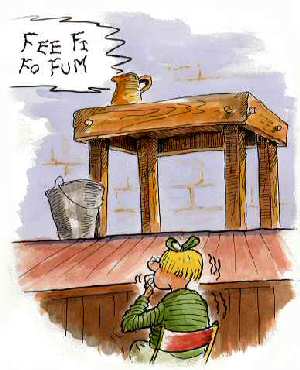SCENERY PAINTING
FOR THE AMATEUR MUSICAL THEATRE and PANTOMIME |
"Oh my dear- how beautiful perspective is" Allegedly spoken by Paolo Uccello (1397-1475) to his wife, on waking in the middle of the night.
If Perspective is a closed book to you, then skip the following section. But I strongly advise you chat to a friendly artist who can give you a rough idea of how Perspective "works".
There are many books devoted to the subject, some delving deeply into the geometry; but you really don't need to know all that for our purpose.
A FEW EASY PRINCIPLES
It's not complicated, honestly it's not. It's something we all acknowledge.....
1. Things appear smaller, the further away they actually are. The most quoted example is- standing in the middle of a road and observing the telephone poles on either side of that road as they seem to disappear into the distance.
2 Door frames; arches etc. have thickness. IT HAS BEEN MY LIFE'S CRUSADE TO BRING MORE "THICKNESS" INTO STAGE SCENERY PAINTING. Of course if you are building a box set complete with actual door reveals etc. then this doesn't apply
3. What you see depends on from where you are looking at it.
A smattering of perspective will give you a very powerful tool to increase the realism of your sets.
THE SPECTATOR'S VIEW OF THINGS
When you are standing at the kitchen doorway you can't see under
the table yet you CAN see under the top shelf? Next lets get down on our
hands and knees (That's confused the dog for a start!). Now you CAN see under
the table.
So what you see, and more importantly in our case, what you EXPECT to see, depends upon your observation point.... where you are sitting/standing in other words.
